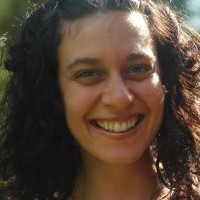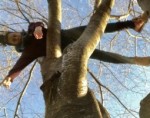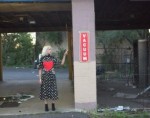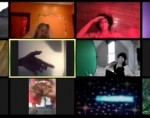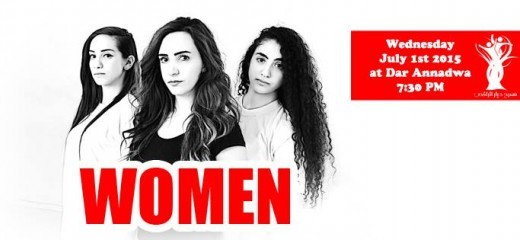
Image: Diyar Dance Theater
Women
by Nicole Bindler
In June 2015 I traveled to Bethlehem, Palestine to make an evening length dance with three young dancers from Diyar Dance Theater, a Dabke company. I was invited by the director, Rami Khader to make a new piece with them about their experiences as women living in the occupied West Bank. What follows are excerpts from my writing about our rehearsal process, the challenges we faced and the questions that arose about cross-cultural collaboration. This piece is also a document of what I observed crossing checkpoints and borders, the prison-like conditions that Palestinians face and how it affects them on a bodily level.
1
At the studio I meet the three young dancers who I’ll be working with: Hala Abusada, age 23; Dima Awad, age 18; and Christy Daboub, age 16. I ask them questions about their lives as women in Palestine and the conversation is stilted. They report that there is nothing extraordinary about their experience as women: there are fewer opportunities for women than men in Palestine, as is the case everywhere. Of course men speak over them and don’t respect their opinions. Men do that everywhere.
I let go of the conversation and guide them through a contact improvisation leading/following exercise where the follower moves with eyes closed. Afterward they report that moving with eyes closed feels very relaxing, but that the role of the leader is challenging for them. I want to investigate the role of the leader more. Why is it difficult for them to direct?
2
I ask them to create a monologue about a time when something didn’t go their way. They practice both in Arabic and English because they will be expected to speak both languages depending on where they are performing. I have them perform their monologues simultaneously with movement phrases they have created.
Dima tells a story—as she swings her arms from side to side and bends her legs into a deep second position plié—about how she was humiliated at a checkpoint. She was forced to go through the metal detector multiple times while a soldier interrogated her about whether she was wearing an underwire bra. As compelling as this story is, Dima feels hesitant to perform it onstage. The women can’t even find a socially acceptable word for bra in Arabic that could be said in mixed company. I feel frustrated that we must let go of such rich material because of cultural conventions, but in this collaborative process the dancers must approve of all the material.
Hala tells a story about when she bought a pair of shoes especially for a trip to the U.S. When she arrived she took them out of the box and discovered that they were both right-footed shoes. Hala practices ballet and she performs the story while in relevé, sternum held high. The juxtaposition of her elegance and the awkwardness of the anecdote is captivating. She agrees to perform this and I plan to buy her two right-footed shoes.
3
When the director Rami and I go to purchase the two right shoes for Hala, we run into his brother-in-law, who insists we come into his clothing store to have orange juice. He gives me mango juice instead, which I’m allergic to, so he runs to the store to get orange juice. The hospitality here is delightful and unnerving. We miss an appointment and Rami is late to pick up his daughter from daycare.
I walk through the streets recording the noise of the city for the sound score. We visit the
wall.
Banksy’s murals were originally created in solidarity with the Palestinian people, but they have become a tourist destination with prints for sale. Rami describes this as an act of resistance turned into a commodity.
Here is an original Bansky mural framed inside a souvenir shop.

Rami shows me his favorite mural, a powerful piece created by Palestinians. He’s disappointed that it’s not framed like Banksy’s art, but instead relegated to a trash dump.
4
Rami and I discuss his work at Diyar and he tells me that much of his time is spent fundraising. International funding for projects in Palestine have enabled a growing middle class to have seemingly normal lives with cars, mortgages, and private school education for their kids (minus freedom of movement.) But this current economy is precarious because it relies so heavily on aid and project-based funding. Plus, much of the energy that was previously spent on resisting the occupation is now spent fundraising for humanitarian projects that actually require the occupation to exist. Rami confides that in essence, the NGO economy creates conditions where some Palestinians have accepted the status quo and are simply working to survive under the current apartheid situation. Rami says he doesn’t believe that resistance and participating in this NGO economy are mutually exclusive. Diyar’s work resists the occupation by maintaining Palestinian art, which is endangered due to cultural
appropriation and the ethnic cleansing of Palestinians. But it’s sometimes difficult for Rami to keep his eye on the prize when he’s swimming in a sea of paperwork.
5
I ask the dancers to help me brainstorm some iconic and omnipresent images in Palestine which we could use in tableaus:
Christy shows us an image of unknown origin that she found on Facebook of a woman playing a violin among soldiers with guns. She suggests that instead of throwing a rock like Faris Odeh, or a bouquet like the Banksy image, that she throw a violin.
6
I work with Hala and Dima on an intimate scene where they braid each other’s hair and discuss the nonexistence of professional dance opportunities in Palestine. While it’s difficult to choose dance anywhere, there are no dance jobs at all in Bethlehem, so they have both chosen alternate career paths. It’s painful to hear their disappointment. Dima had wanted to study dance in the U.S. and I had tried to get her a scholarship to a Philadelphia university but was unable to get her the full award. Instead she’s going to Birzeit in Ramallah this fall to study nutrition.
7
I spend the day working on the
sound score. I integrate the Arab music we’re using in rehearsal with my field recordings from the Bethlehem market, downloaded sounds of fighter jets, the sea, and war exercises. I take a break and walk to Bethlehem from Beit Sahour. At a bustling traffic circle I have a hard time figuring out how to cross the street. A man in a truck stops and says to me in English: “Do you need help?”
On my way home I see a car in a tree.
8
Rami gathers rocks from the rubble that can be found on the side of every road, and we use them to create a map of Palestinian cities. It is sad and chilling to watch the women name the cities in Arabic that now exist across the
Green Line under Israeli names.
Dima creates a new monologue about how a man in her community recently told her it’s not okay for her to wear a tank top. She points to her t-shirt and says: “Why is this ok?” then pulls the sleeve up to reveal her shoulder: “And this is not ok?”
The dancers are confused about why they’re speaking about seemingly unrelated things as they dance. I tell them about the surrealists, the concept of juxtaposition and show them
this image by Hans Hemmert, that beautifully illustrates counterpoint.
9
Rami has invited me here to instill in the company new practices and ideas. He wants us to make a provocative, feminist work together. I want to gently prod the women toward the unknown but also learn from them and maintain a safe space. They are accustomed to hierarchical structures where the choreographer tells them exactly what to do. That is what feels familiar and safe. I am asking them to develop the dance with me based on their interests, goals, and dreams. I sometimes feel that I am foisting a collaborative process onto them and wonder if there is a tyranny to this strange democracy I’m proposing.
10
We play sounds of the Israeli military ordering people home as the dancers perform the tableaus of iconic Palestinian images. Then we add the sound of fighter jets to the hair braiding section. As they perform these sections, the women begin to recognize juxtaposition as a powerful tool to illustrate the simultaneous banality and terror in their lives.
11
We create a new section with sea sounds and water bowls at the edge of the Palestine they have created with rocks. They dabble their fingers in the bowls and travel to the Mediterranean in their minds. They have all been there (only an hour away) just a few times. They tell me they were unable to relax because they felt like foreigners in their own home.
12
I’m headed to Jerusalem. At a checkpoint there are 100 people waiting to get through a single turnstile that unlocks with a green light about once every five minutes. The crowd swarms around the turnstile. There’s no line, no order, and people argue about whose trip is more urgent. The Palestinian travelers, some of whom are commuting workers and many of whom are going to pray at the mosque for Ramadan, turn against one another in this senseless, sadistic human experiment. When the crowd becomes rowdy, a soldier with a machine gun runs out on a catwalk above to yell menacingly. Many people turn around and decide to go home.
13
Hala stands in the middle of the rock-map of Palestine and charts the cities on her body. She suggests she name destroyed villages instead of existing cities, but we realize we have to find out their names and locations because we only know of a few. Rami laments that many Palestinians have forgotten the names of the villages destroyed in 1948.
14
I receive a Jewish Currents article from a friend. I learn that one of my dance heroines, Liz Lerman, created a
dance similar to Hala’s solo for Israel’s 50th anniversary, but instead of destroyed Palestinian villages, she names Israeli cities. On her website it describes her piece: “In one of the piece's most striking segments, Lerman invites the audience to imagine that her body is the map of Israel, using text and movement to literally and figuratively demarcate the state's contentious borders and boundaries. Pointing to her forehead, she locates Haifa, and uses her hands to draw a line from her feet up past her head to represent the sprawl of resorts in Eilat...”
15
I have lunch with Basem Sbaih from
Badil, an organization that advocates for Palestinian refugees. He spends an hour pouring over pre-1948 maps to help me find the names and locations for Hala’s monologue.

He takes me to Beit Jala and points to
Al Walaje, a village on a hill to the right of us that is surrounded by settlements and is entirely enclosed by the wall. Inhabitants must use a special permit to enter and use a single road to access their town. They are cut off from their neighboring communities and their families there who are not allowed to visit them. There is one doubly imprisoned family from the village whose house lies outside of the wall. It is too expensive to man a checkpoint at the wall for a single house so the Israeli government has come up with an absurd solution. They are building a tunnel from Al Walaje center under the wall to the home and surrounding it with an electrified fence so that the tunnel is the only way in or out and the family is caged in like cattle.
16
We have our first rehearsal in the theater and spend the whole time mapping out the space. This dance uses the whole stage space, including the edges of the back curtain, the lip of the stage and all four corners. Sometimes the dancers creep toward center, as if the edges are an unpleasant place.
I bring up the idea that if we’re telling the story of the marginalization of Palestinian women, we need to use the margins of the stage space. There are often activities in the center, but what’s interesting is how those activities relate to what’s happening at the periphery. How can we bring what and who exists at the margins into the light?
17
Two hundred people show up to see the performance on a Wednesday night during Ramadan, which is a great turnout. The trio dances beautifully, yet I see how the piece is still unfinished. The poignancy of the grief about land loss and yearning for the sea is cut short by an upbeat ending that needs more explanation. But how can we expect to have a finished work in three weeks? Even though the piece needs some filling out with content, the dancers fill in the holes with their convincing and committed performances. They are in it.
At the Q&A members of the audience want to understand what all the images mean. Why are the dancers naming rocks as cities? Why are there water bowls? Is that supposed to be the sea or does it represent water scarcity? Why do so many of the scenes repeat with different music? Why is there so much stillness and silence? Many of them have never seen nonlinear performance before and I wish we had given them more of a way in, to allow the images to wash over them, to have multiple interpretations and to not worry about “getting it.”
We celebrate our achievement over ice cream and hold on to the positive response we received from several women in the audience who said they saw their feelings and experience reflected back to them from the stage.
18
Rami and I have an evaluation conversation at a cafe near my apartment. We want to develop the piece further and create some audience engagement activities so that it can be contextualized for either Middle Eastern or Western audiences. We brainstorm curtain speeches and conversation starters for Middle Eastern audiences who may have not been exposed to Western concert dance. We get excited about educational programming that could support the dance in the U.S. and Europe. We want to hold Dabke classes and lectures on Palestinian culture, its history, and how it is appropriated. We come up with a preliminary plan for fundraising and touring.
We say goodbye, certain that this is just the beginning, and I head back to Tel Aviv. The bus is full and we are stopped at the checkpoint and forced off the bus for inspection. We wait in the noonday sun next to the hot exhaust of the idling bus. It takes the Israeli soldiers 30 minutes to inspect the bus and our IDs. When I get back on the bus my skin is tender and red.
I arrive in Tel Aviv that afternoon and spend the evening with the parents of an Israeli friend. They give me a purse to remember Israel.
It looks just like the purse the dancers gave me to remember Palestine.

By Nicole Bindler
October 9, 2015


.jpg)
.jpg)







